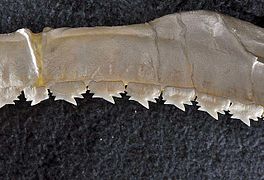Prickly shark
| Prickly shark | |
|---|---|

| |
| Scientific classification | |
| Domain: | Eukaryota |
| Kingdom: | Animalia |
| Phylum: | Chordata |
| Class: | Chondrichthyes |
| Subclass: | Elasmobranchii |
| Subdivision: | Selachimorpha |
| Order: | Squaliformes |
| Family: | Echinorhinidae |
| Genus: | Echinorhinus |
| Species: | E. cookei
|
| Binomial name | |
| Echinorhinus cookei Pietschmann, 1928
| |

| |
| Range of the prickly shark[2] | |
The prickly shark (Echinorhinus cookei) is one of the two
Taxonomy
Austrian
Description
The prickly shark has a flabby and cylindrical body, with the adults markedly bulkier than juveniles, and a short, moderately flattened head. The nostrils are placed far apart and preceded by small flaps of skin. The spiracles are tiny and positioned well behind the eyes, which lack nictitating membranes. The mouth forms a broad arch, with very short furrows at the corners. There are 21–25 and 20–27 tooth rows in the upper and lower jaws respectively. The knife-like teeth each have a strongly angled main cusp flanked by up to three smaller cusplets on either side; the lateral cusplets are absent in young sharks. There are five pairs of gill slits, with the fifth pair the longest.[7][8][9]
The
-
Head
-
Head, bottom view
-
Jaws
-
Upper teeth
-
Lower teeth
Distribution and habitat
The prickly shark is widely distributed around the
Favoring cooler temperatures of 5.5–11 °C (41.9–51.8 °F), the prickly shark is mostly found below depths of 100–200 m (330–660 ft), particularly in the
Biology and ecology

The prickly shark is a slow swimmer and has been observed hovering just above the
The size and structure of the prickly shark's mouth and
Human interactions
Interactions with divers show that the prickly shark behaves inoffensively towards humans, either tolerating contact or fleeing when closely approached.
Conservation status
In June 2018 the New Zealand
References
- ^ . Retrieved 18 November 2021.
- ISBN 9780691120720.
- ^ Pietschmann, V. (1928). "Neue Fischarten aus dem Pazifischen Ozean" [New fish species from the Pacific Ocean]. Anzeiger der Akademie der Wissenschaften in Wien (in German). 65 (27): 297–298.
- ^ Pietschmann, V. (1930). "Remarks on Pacific fishes". Bernice P. Bishop Museum Bulletin. 73: 1–244.
- ^ Garrick, J.A.F. (1960). "Studies on New Zealand Elasmobranchii. Part X. The genus Echinorhinus, with an account of a second species, E. cookei Pietschmann, 1928, from New Zealand waters" (PDF). Transactions of the Royal Society of New Zealand. 88 (1): 105–117.
- ^ Froese, R.; Pauly, D. (eds). "Echinorhinus cookei". FishBase. March 2012 Version. Downloaded on March 25, 2012.
- ^ ISBN 9780195392944.
- ^ ISBN 978-9251013847.
- ^ ISBN 978-0520222656.
- ^ S2CID 85331266.
- ^ .
- ^ a b Dawson, C.L. (2007). "Prickly shark, Echinorhinus cookei, movement and habitat use in the Monterey Canyon Archived 2014-05-21 at the Wayback Machine". M.Sc. Thesis, San Francisco State University.
- ^ Barry, J.P.; Maher, N. (2000). "Observation of the prickly shark, Echinorhinus cookei, from the oxygen minimum zone in Santa Barbara Basin, California". California Fish and Game. 86 (3): 213–215.
- ^ Martin, R.A. "Echinorhiniformes: Bramble Sharks". ReefQuest Centre for Shark Research. Downloaded on March 25, 2012.
- ISBN 978-0674034112.
- OCLC 1042901090.
External links






